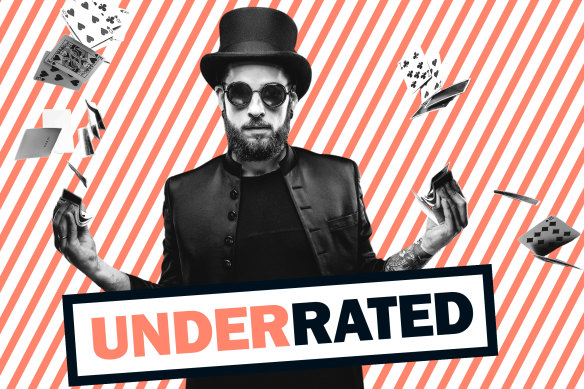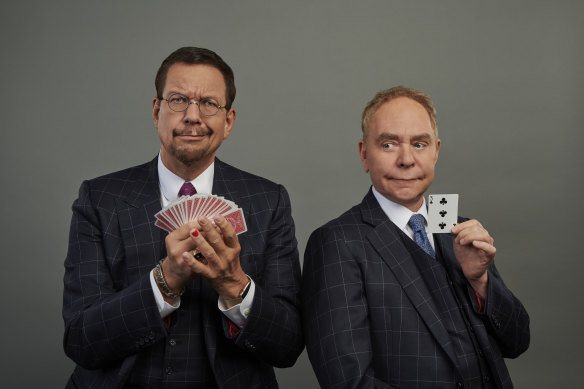Save articles for later
Add articles to your saved list and come back to them any time.
For many, it’s the most wonderful time of the year. Yes, Goth Christmas is upon us once again, darkening our souls with fun treats and costumes for kids, sexy get-ups for the adults (hello, Wednesday Addams and Barbie and Ken), a deluge of demonic movies, and people getting irrationally annoyed about pumpkin spice lattes.
Halloween is a big, spooktacular deal, despite the grumbling by grinchy curmudgeons that it’s US commercialisation invading our culture. One in four Australians marks Halloween in some way, splashing out about $430 million on treats, costumes, decorations and parties (that’s a slightly terrifying $86 per person for those who observe).
Let’s bring the magic back to magic.Credit: Janet Briggs
But while we’re caught in the web of this nonsense, I’d like to take a moment to put a spotlight on part of this fun world that gets rudely overlooked: stage magic. Actual magic. Rabbits in hats. Ladies sawn in half. Sleight-of-hand card tricks. Why is the feat of conjuring up magic right in front of our very eyes such an uncool part of this world of dark forces, sorcery, mystery and the unexplained? Halloween has all the good times, but its trickster relative is mostly just very, very lame.
I’m calling for a reframing of magic. Let’s bring it back under Halloween’s careful (bat)wing and allow ourselves to believe magic is real. Halloween and performance magic actually share the same origin story when you dig into it, with beginnings in folklore, the supernatural and illusion. In 1584, Englishman Reginald Scot wrote The Discoverie of Witchcraft, “wherein the lewde dealing of witches and witchmongers is notablie detected”. It’s important because it was the first text to expose methods of tricks, which Scot did in an attempt to debunk supernatural beliefs and to stop the killing of suspected witches. It was effectively the first Manual of Magic, as well as rather helpfully stopping women being murdered.
A French book that same year, the delightfully titled The First Part of Clever and Pleasant Inventions by Jean Prevost, similarly lifted the lid on the how-to of conjuring. Both of these books were such seminal texts that the trade secrets they revealed still remain at the heart of sleight-of-hand tricks today.
But perhaps herein lies the problem with magic. Does knowing it’s a trick someone has learnt and practised ruin the actual magic? Is suspending disbelief, ditching our logical brains, going with our heart rather than our heads, so hard when there’s clear evidence to the contrary? Whereas with ghosts and demons and all the other gubbins that make Halloween so enticing, is it because there’s no tangible evidence that it remains an unknown, and thus potentially – potentially – real?
Penn and Teller: keeping magic alive, the right way.
History professor Michael D. Bailey from Iowa State University specialises in magic, witchcraft and superstition – imagine that being your job, now that’s cool – and explains why he thinks stage magic gets a bad rap. He says in the late 18th century, many western European countries brought in laws to make it a crime to practise witchcraft or for a person to claim they had magical powers. People who had been making their living this way or performing illusions to keep an income had to then basically sell it simply as tricks. Modern stage magic in the mid- to late-19th century continued that explicit descriptor of trickery – the disclaimer that no occult forces were involved.
Later on, stage magicians became expert debunkers of spirit mediums, fortune-tellers and so on, exposing the fraudsters with insider knowledge of how tricks were done. Essentially, our magicians became narcs, the informants of the magic world, and they weren’t here to win friends.
“Long story short,” says Bailey, “modern stage magic has a pronounced history of presenting itself as entertaining trickery but decidedly not scary, occult, or otherworldly, which are the things that now make Halloween ‘cool’.”
There have been some good times for magic. Frenchman Jean-Eugene Robert-Houdin is seen as the founding father of stage magic, and succeeded in taking it from circus sideshows to the middle-classes and Parisian theatres in the mid-1800s. One of the best-known figures is Harry Houdini, who took his name in honour of Robert-Houdin and wowed audiences across the world in the early 1900s with daring feats of escapology involving handcuffs, chains, straitjackets, water tanks and being buried alive. The thrill of his act was essentially that he could die if he failed – and audiences loved it. He became the first superstar of the trade, and to this day inspires countless mediocre contestants on TV talent shows.
Which brings me back to my main point: how did we get here? We had fake witches and a daredevil escape artist. That’s fun! But when I think of magic today, I think of bad hair and bad waistcoats, dry ice and terrible synth music, and tired old tricks we have seen variations of for decades. So how do we spark up magic again?
There has been some cool stuff. Harry Potter can have a hat tip, UK mentalist Derren Brown has pulled off dazzling mind control feats and US endurance showman David Blaine has succeeded in several high-profile stunts, as well as having a solid squad of cool bros in Leonardo DiCaprio and Tobey Maguire.
If you look at what’s on in Vegas, the long-time home of upgraded cruise ship entertainers Siegfried and Roy and their white lions, you’ve still got hair criminals David Copperfield and Criss Angel filling out venues. But also in Vegas, in fact as the town’s longest-serving magical performers, are Penn & Teller, whose offbeat schtick as comedic sceptics, who also give away the odd tricks of the trade too, has served them well.
Teller has been quoted as saying magic is “telling a beautiful lie”, and this is the bit I want to tap into. There’s a long and fascinating history to magic. In an era where we’re bombarded with conspiracy theorists and other internet morons, I want to join them in ignoring all logic and rational thought, but do it for magic. I want to suspend disbelief and embrace the delight in the sorcery in front of me.
Let’s bring the magic back to magic. I want magic to be cool enough to join our Halloween party. Or at least give the illusion of cool and make tricks the treat.
Find out the next TV, streaming series and movies to add to your must-sees. Get The Watchlist delivered every Thursday.
To read more from Spectrum, visit our page here.
Most Viewed in Culture
From our partners
Source: Read Full Article




